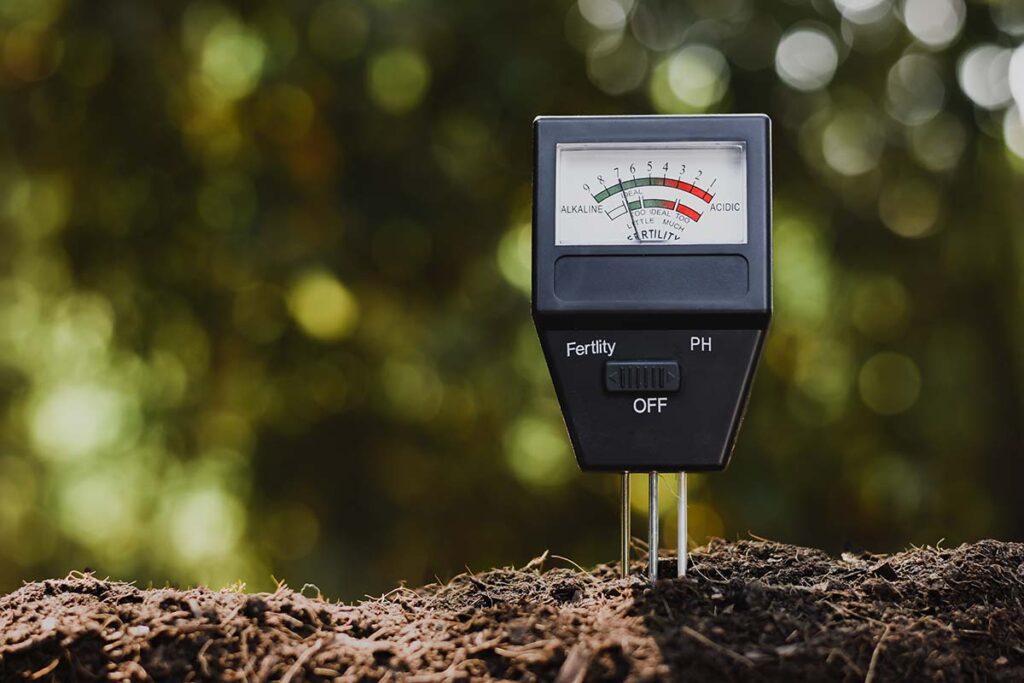Testing garden or lawn soil for pH and nutrients helps guarantee your growing success. Do you know if your soil is healthy? Adding lots of organic material helps assure that your soil is alive with microbes, maintains a balance of nutrients, and has good drainage. But what about its acid-alkaline balance, the measurement known as pH? What about the nutrients that plants need to be healthy and resist pests and diseases?

Testing soil — especially new garden soil — helps guarantee that your vegetables and other plants will do their best during the growing season. Springtime, just before you begin planting, is the best time to do it.
There are home testing kits that can be very effective and can make soil testing easy. You don’t need to understand soil pH and its importance to your plants in any great detail. The potential of Hydrogen (pH), the measure of how acidic or alkaline a soil is, is measured on a scale of 1 to 14, with 7 being neutral.
The right soil pH can make your garden thrive.
Most vegetables grow well in a pH range of 6.5 to just above 7.0, though some, including corn, carrots, cucumbers, and tomatoes, will tolerate soil pH down to 5.5. Potatoes prefer acidic soils and grow best from 6.0 to 5.0. Providing the proper soil pH for your plants is all about nutrition uptake. Your plants can’t get the proper nutrients they need if those nutrients are unavailable because of improper pH conditions.
It is also important to test for the big three in plant nutrition: nitrogen (N), phosphorous (P), and potassium (K). Again, there are home kits available, as well as electronic meters that will give you a good idea of any deficiencies you may need to correct.
Micronutrients are also important to growing gardens that give strong yields while resisting pests and diseases. Most home garden kits don’t measure for these components. Your local university extension service might be able to help. They may provide the most accurate and detailed soil analysis available and if you live in a state whose universities offer the service, take advantage. If an extension service is not readily available or your state university no longer offers the service, you can use a private service.
The right pH for your lawn – why it matters.
Having the perfect pH level in your soil is important for your lawn to absorb the nutrients they need to grow. Lawns with a low or acidic pH also grow unwanted plants like weeds or moss. So, if you want a beautiful dark green lawn, you need to test the soil pH levels regularly and adjust accordingly. The exact number for your soil’s pH level should be around a range of 6.0 – 6.5 – 7.0, depending upon what type of turf you have for your lawn.
Lawns thrive in slightly acidic soil, so ensuring your soil is in the right range is key to getting a beautiful lawn. Each grass type can survive at a different pH level. You can talk with your lawn care professional about the optimal soil pH level for your lawn. A lawn with too acidic soil can be adjusted with lime, while one that is too alkaline can be adjusted with sulfur. Applying lime for lawns’ pH levels can also help keep thatch from building up, as can sulfur. Adjusting these two items can also help fertilizer work more effectively. In addition, adjusting the pH level can also keep your lawn from turning yellow and help the grass absorb nutrients more readily.
Don’t forget that you should have the type of grass ideal for your climate and your area’s soil. If you do not, you will fight a losing battle regarding your soil’s pH level and having a lush, healthy lawn. Not sure what type of grass is ideal for your climate? Check out our blog on finding the right type of grass for your area.
After determining your proper pH level, fertilizing is your next step. See our spring, summer, and autumn fertilizing guides for more info on what to do seasonally.




